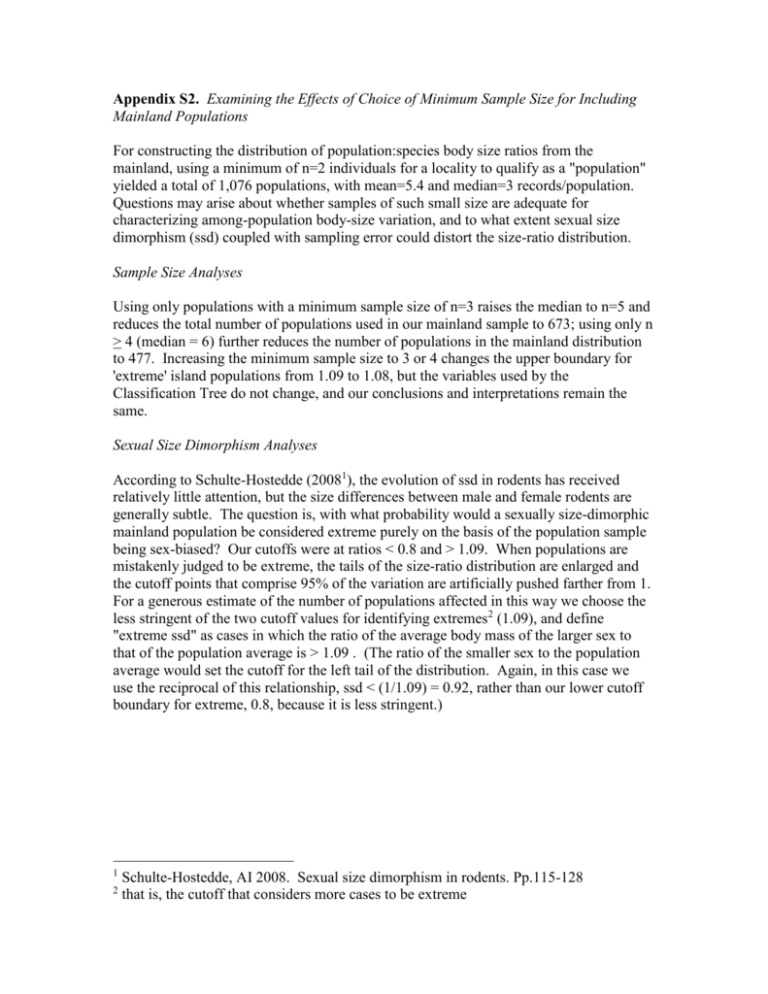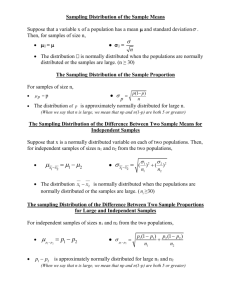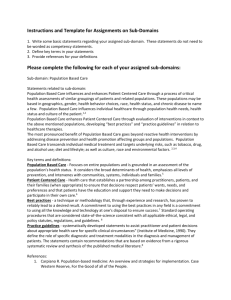
Appendix S2. Examining the Effects of Choice of Minimum Sample Size for Including
Mainland Populations
For constructing the distribution of population:species body size ratios from the
mainland, using a minimum of n=2 individuals for a locality to qualify as a "population"
yielded a total of 1,076 populations, with mean=5.4 and median=3 records/population.
Questions may arise about whether samples of such small size are adequate for
characterizing among-population body-size variation, and to what extent sexual size
dimorphism (ssd) coupled with sampling error could distort the size-ratio distribution.
Sample Size Analyses
Using only populations with a minimum sample size of n=3 raises the median to n=5 and
reduces the total number of populations used in our mainland sample to 673; using only n
> 4 (median = 6) further reduces the number of populations in the mainland distribution
to 477. Increasing the minimum sample size to 3 or 4 changes the upper boundary for
'extreme' island populations from 1.09 to 1.08, but the variables used by the
Classification Tree do not change, and our conclusions and interpretations remain the
same.
Sexual Size Dimorphism Analyses
According to Schulte-Hostedde (20081), the evolution of ssd in rodents has received
relatively little attention, but the size differences between male and female rodents are
generally subtle. The question is, with what probability would a sexually size-dimorphic
mainland population be considered extreme purely on the basis of the population sample
being sex-biased? Our cutoffs were at ratios < 0.8 and > 1.09. When populations are
mistakenly judged to be extreme, the tails of the size-ratio distribution are enlarged and
the cutoff points that comprise 95% of the variation are artificially pushed farther from 1.
For a generous estimate of the number of populations affected in this way we choose the
less stringent of the two cutoff values for identifying extremes2 (1.09), and define
"extreme ssd" as cases in which the ratio of the average body mass of the larger sex to
that of the population average is > 1.09 . (The ratio of the smaller sex to the population
average would set the cutoff for the left tail of the distribution. Again, in this case we
use the reciprocal of this relationship, ssd < (1/1.09) = 0.92, rather than our lower cutoff
boundary for extreme, 0.8, because it is less stringent.)
1
2
Schulte-Hostedde, AI 2008. Sexual size dimorphism in rodents. Pp.115-128
that is, the cutoff that considers more cases to be extreme
Thus for small samples and sex bias to alter our results, we expect the following:
(size of larger sex) / (average of two sexes) > 1.09
Let "ssr" refer to the within-species dimorphism ratio (size of one sex/ size of other sex).
Then
ssr / ((ssr+1)/2) > 1.09
ssr > 1.09 * ((ssr+1)/2) = (ssr + 1) * 0.545
ssr > 0.545 + (0.545*ssr)
(1 - 0.545) * ssr > 0.545
0.455 * ssr > 0.545
ssr > 0.545 / 0.455 = 1.20
thus, ssr > 1.20 , or, working with the reciprocal
relationship, the ratio of sizes of smaller/larger, ssr < 1 / 1.20 = 0.83
The frequency of extreme ssd (as defined above) in Schulte-Hostedde's (2008: Table 3)
tabulations of rodent body-mass female/male ratios is 36%.
In the tails of our distribution of 1,076 population body-size ratios there are 12 Small and
20 Big populations in which n=2. The binomial probability of sampling two individuals
of the larger sex in such populations is 1/4, or an estimated 5 of the Big populations; the
probability of sampling two individuals of the smaller sex is 1/4, or an estimated 3 of the
Small populations. Judging from Schulte-Hostedde's tabulations, 36% of these
populations would exhibit extreme ssd: roughly one of the Small, and two of the Big.
Eliminating this number of populations from the tails of the distribution produces no
change in the lower cutoff ratio and shifts the upper cutoff from 1.09 to 1.082.
For 11 (5 Small, 6 Big) of our extreme populations, n=3 , and the binomial probability of
sampling only the smaller sex in such populations is 1/8. 36% * (5/8) = 0.225; or for
sampling only the larger sex, 36% * (6/8) = 0.27 -- fewer than one in each tail.
Eliminating this additional number of populations from the tails of the distribution again
does not change the lower cutoff ratio and shifts the upper cutoff to 1.076.
Sampling bias could also affect populations of n > 3, but the probability of having
enough representatives of the wrong sex in a species with extreme ssd becomes
diminishingly small.
As noted above, shifting the boundaries for ‘extreme’ populations to account for sexual
size dimorphism (from 1.09 to 1.076 for the upper boundary, no change to the lower
boundary) does not alter the structure of the Classification Tree, and our conclusions and
interpretations remain the same.









